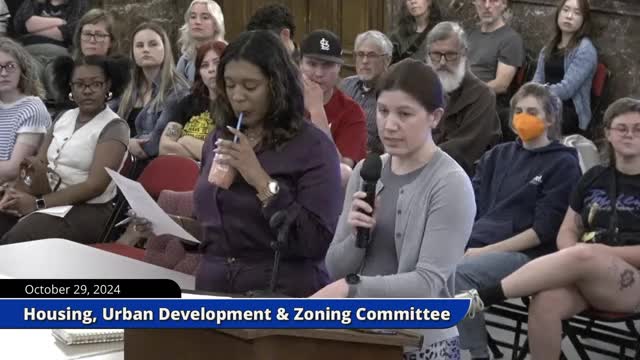Housing summit aims to tackle regional homelessness crisis
November 05, 2024 | St. Louis City, St. Louis County, Missouri
This article was created by AI summarizing key points discussed. AI makes mistakes, so for full details and context, please refer to the video of the full meeting. Please report any errors so we can fix them. Report an error »

During a recent meeting of the Housing, Urban Development, and Zoning Committee, significant discussions emerged regarding the city's approach to addressing homelessness and the need for a coordinated housing strategy. A representative, unable to attend the hearing, submitted key points highlighting the outcomes of a regional housing summit convened with various stakeholders, including housing authorities and service providers.
The summit aimed to develop a comprehensive plan to support the unhoused population, focusing on creating an emergency rehousing system tailored to community needs. The initiative emphasizes the importance of long-term housing solutions while acknowledging that immediate placements may not be feasible for everyone. In the interim, the plan seeks to ensure that shelters and supportive housing options are available to assist individuals preparing for rehousing.
The Department of Human Services (DHS) currently funds 314 emergency beds, supported by multiple funding sources, including the St. Louis Affordable Housing Trust Fund and the Missouri Housing Trust Fund. However, the meeting underscored a critical shortage of affordable housing and insufficient vouchers, with the average time individuals spend unhoused reaching 776 days. Those in emergency shelters wait an average of 242 days before transitioning to permanent housing.
The committee was informed that over 1,200 individuals are counted in the annual point-in-time survey, living in shelters, transitional housing, or on the streets. The representative stressed the urgency of creating a coordinated system to enhance safety and support for these individuals, especially given that there were over 400 turnaways from emergency shelters last month.
DHS has collaborated with local officials to refine legislation aimed at improving the operational plans for service providers, ensuring that facilities align with the broader regional housing strategy. The discussions highlighted the pressing need for a more effective system to reduce homelessness and improve the living conditions of vulnerable populations in the community.
The summit aimed to develop a comprehensive plan to support the unhoused population, focusing on creating an emergency rehousing system tailored to community needs. The initiative emphasizes the importance of long-term housing solutions while acknowledging that immediate placements may not be feasible for everyone. In the interim, the plan seeks to ensure that shelters and supportive housing options are available to assist individuals preparing for rehousing.
The Department of Human Services (DHS) currently funds 314 emergency beds, supported by multiple funding sources, including the St. Louis Affordable Housing Trust Fund and the Missouri Housing Trust Fund. However, the meeting underscored a critical shortage of affordable housing and insufficient vouchers, with the average time individuals spend unhoused reaching 776 days. Those in emergency shelters wait an average of 242 days before transitioning to permanent housing.
The committee was informed that over 1,200 individuals are counted in the annual point-in-time survey, living in shelters, transitional housing, or on the streets. The representative stressed the urgency of creating a coordinated system to enhance safety and support for these individuals, especially given that there were over 400 turnaways from emergency shelters last month.
DHS has collaborated with local officials to refine legislation aimed at improving the operational plans for service providers, ensuring that facilities align with the broader regional housing strategy. The discussions highlighted the pressing need for a more effective system to reduce homelessness and improve the living conditions of vulnerable populations in the community.
View full meeting
This article is based on a recent meeting—watch the full video and explore the complete transcript for deeper insights into the discussion.
View full meeting
